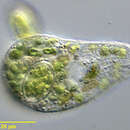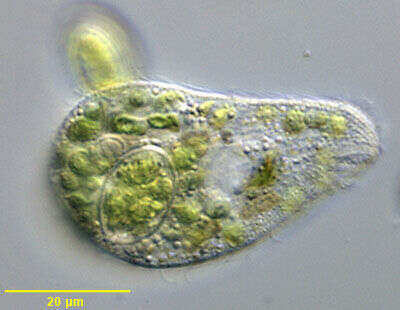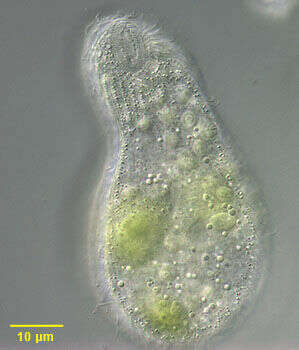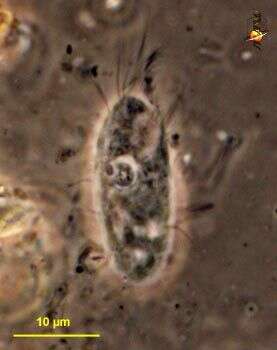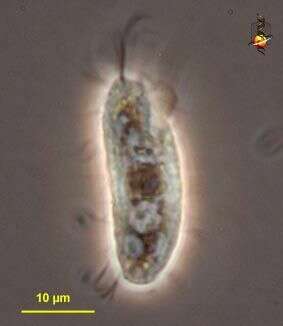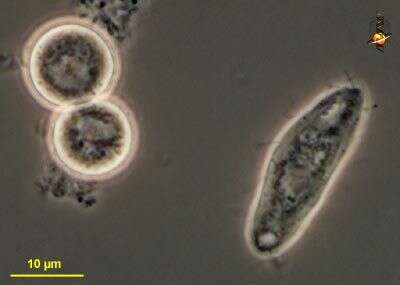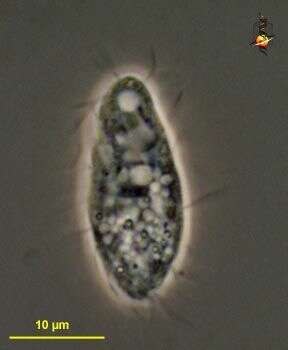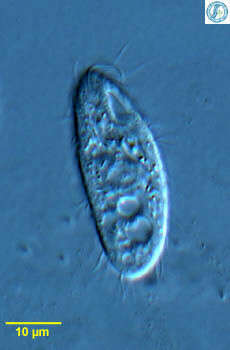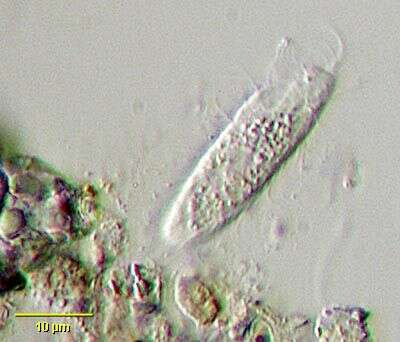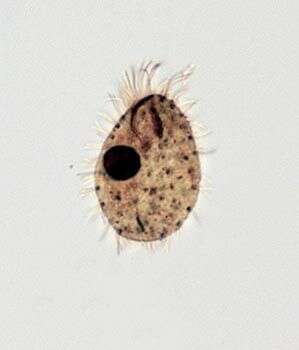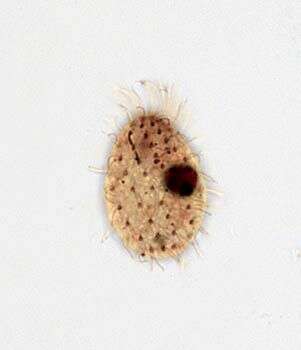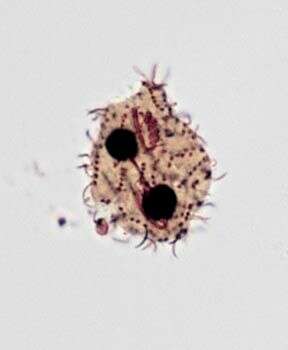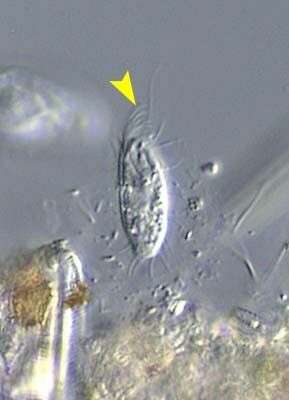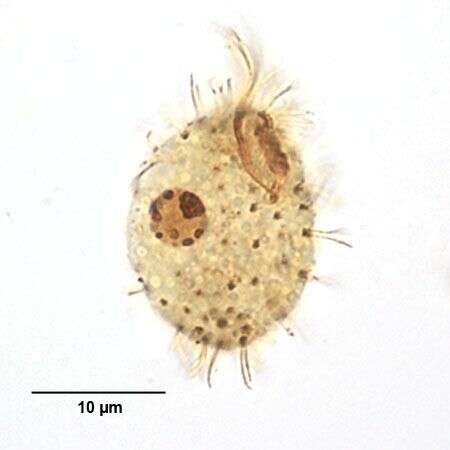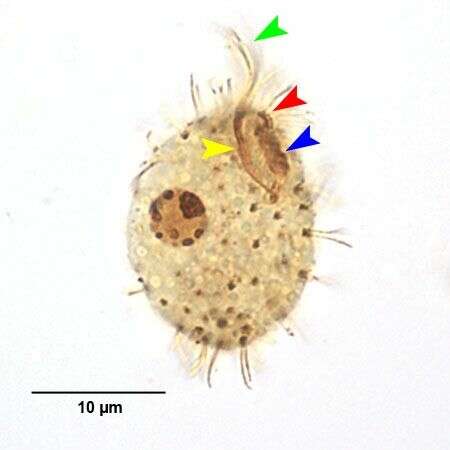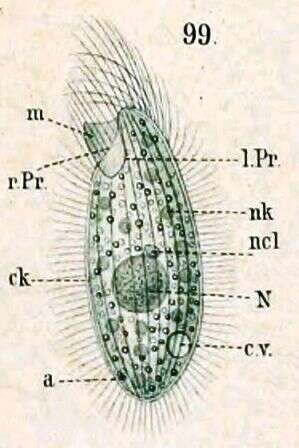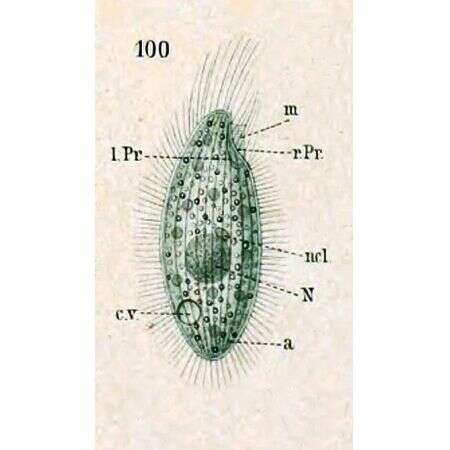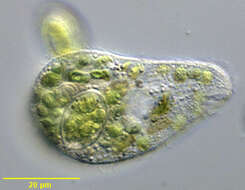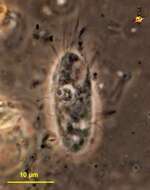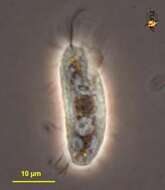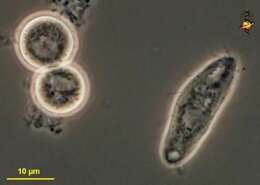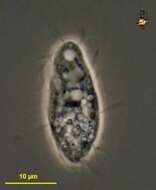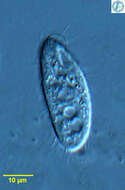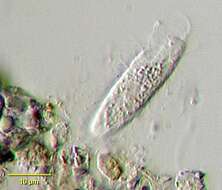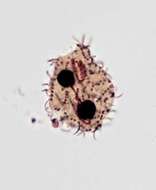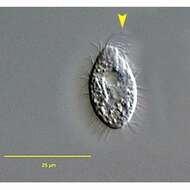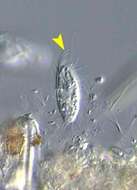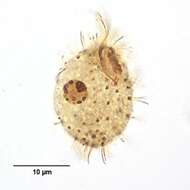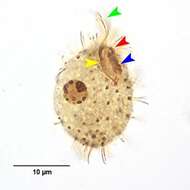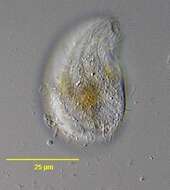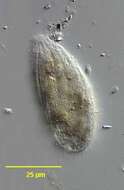-
Portrait of Platyophrya sphagni, a colpodid ciliate. Cells are flask shaped with an indistinct subapical oral aperture. The cells are very flexible and squirm about rather slowly along the substratum. When swimming they tend to rotate around their long axis. The right lateral surface is more densely ciliated than the left (best seen anteriorly here). The cytoplasm contains both large ingested algae and smaller symbiotic zoochlorellae which distinguish this species from other members of the genus. The central macronucleus and micronucleus are seen in this image. Many small extrusomes are also seen in this image. From freshwater pond near Boise, Idaho. DIC optics.
-
Ventral view of Platyophrya sphagni, a colpodid ciliate. Cells are flask shaped with an indistinct subapical oral aperture (well seen in this image). The cells are very flexible and squirm about rather slowly along the substratum. When swimming they tend to rotate around their long axis. The oral aperture has a right paraoral membrane, and is bordered on the left by a row of adoral organelles and an outer "postoral pseudomembrane". The right lateral surface is more densely ciliated than the left. The cytoplasm contains both large ingested algae and smaller symbiotic zoochlorellae which distinguish this species from other members of the genus. Many small extrusomes are also seen in this image. From freshwater pond near Boise, Idaho. DIC optics.
-
Cyrtolophosis (sir-till-owe-foe-sis) ciliate usually located in a flimsy mucus sheath, recessed mouth with small arc of projecting cilia. Eats bacteria. Phase contrast.
-
Cyrtolophosis (sir-till-owe-foe-sis) ciliate usually located in a flimsy mucus sheath, recessed mouth with small arc of projecting cilia. Eats bacteria. Phase contrast.
-
Cyrtolophosis (sir-toe-low-foe-sis), usually found in mucus sheaths, with only the anterior end projecting. Typically with a quiff of anterior cilia, and the mouth located just subapically. Cysts also form. Phase contrast micrograph.
-
Cyrtolophosis (sir-toe-low-foe-sis), usually found in mucus sheaths, with only the anterior end projecting. Typically with a quiff of anterior cilia, and the mouth located just subapically. Cysts also form. Phase contrast micrograph.
-
This is a ciliate which consumesbacteria, the mouth being located to the upper right of this cell. Usually found in a mucus tube. From Lake Donghu, China. Differential interference contrast micrograph.
-
Cyrtolophosis, a colorless colpodid ciliate most often found in a mucous sheath (seen in this image) possibly secreted by mucocysts. Cells often flee the mucous sheath and swim free when transferred to a microscope slide. There is a characteristic prominent anterior ciliary tuft and well developed 'adoral ciliary organelles" (similar in appearance to an undulating membrane) along the left margin of the buccal cavity (both are seen in this image). From temporary rainwater pool in grass field near Boise, Idaho. Oblique illumination
-
Portrait of Cyrtolophosis mucicola (Stokes,1885). An individual is seen here just fleeing its mucus dwelling tube (to viewer's left of organism). The tube is apparently formed from the contents of mucocysts.Collected from a freshwater pond near Boise, Idaho. July 2005.Phase contrast.
-
Ventral infraciliature of Cyrtolophosis mucicola (Stokes,1885). The paraoral membrane is seen to the viewer's right and the adoral membranelles to the left.A short "oblique kinety" is present between the anterior end of the paraoral membrane and the most anterior adoral membranelle. The sparse (~10) slightly spiralled somatic kineties are visible.Collected from a freshwater pond near Boise, Idaho.June 2005). Stained by the silver carbonate technique (see Foissner, W. Europ. J. Protistol., 27:313-330;1991). Brightfield.
-
Dorsal infraciliature of Cyrtolophosis mucicola (Stokes, 1885).The sparse (~10) slightly spiralled somatic kineties are seen here.Collected from a freshwater pond near Boise, Idaho.June 2005). Stained by the silver carbonate technique (see Foissner, W. Europ. J. Protistol., 27:313-330;1991). Brightfield.
-
Ventral infraciliature of Cyrtolophosis mucicola (Stokes,1885)in middle division. The paraoral membrane is seen to the viewer's right and the adoral membranelles to the left.A very short "oblique kinety" is present between the anterior end of the paraoral membrane and the most anterior adoral membranelle. The sparse (~10) slightly spiralled somatic kineties are visible.The oral apparatus of the forming posterior daughter cell (opisthe) is obscured by its densley stained macronucleus. Collected from a freshwater pond near Boise, Idaho.June 2005). Stained by the silver carbonate technique (see Foissner, W. Europ. J. Protistol., 27:313-330;1991). Brightfield.
-
Cyrtolophosis mucicola STOKES,1885. The yellow arrowhead indicates the anterior tuft of elongated cilia. DIC.
-
Cyrtolophosis mucicola STOKES,1885. The yellow arrowhead indicates the anterior tuft of elongated cilia. DIC.
-
Infraciliature (right ventrolateral view) of Cyrtolophosis mucicola (STOKES,1885). Stained by the silver carbonate technique (Foissner,W. Europ. J. Protistol.27:313-330;1991).Brightfield.
-
Infraciliature (right ventrolateral view) of Cyrtolophosis mucicola (STOKES,1885). The red arrowhead indicates athe short oblique kinety located anterior to the 1st of the 4 adoral membranelles (blue arrowhead).The right paroral membrane is indicated by the yellow arrowhead. The elongated anterior tuft of cilia (green arrowhead) arise from the anterior part of the right paraoral membrane. Stained by the silver carbonate technique (Foissner,W. Europ. J. Protistol.27:313-330;1991).Brightfield.
-
Described by Schewiakoff under the name Bantiophorus minutus nov. gen. et spec., 1889. Key to abbreviations: a -- Anus cv -- Contractile vacuole ek -- Ectoplasm l.Pr -- Left edge of peristome m -- Undulating membrane N -- Macronucleus ncl -- Micronucleus r.Pr -- Right edge of peristome nk -- Food particle
-
Described by Schewiakoff under the name Balantiophorus minutus nov. gen. et spec., 1889. Right side view. Key to abbreviations: a -- Anus cv -- Contractile vacuole m -- Undulating membrane l.Pr -- Left edge of Peristome N -- Macronucleus ncl -- Micronucleus r.Pr -- Right edge of peristome ncl --
-

Right ventrolateral view of the infraciliature of the colpodid ciliate, Platyophrya vorax (Kahl,1926). The flask-shaped cells are very flexible. The relatively small ovoid anterior cytostome is subapical. There is a right paraoral membrane composed of dikinetids and four rectangular left adoral membranelles . There is a postoral "pseudomembrane" consisting of closely spaced anterior dikinetids of somatic kineties. The right side is more densely ciliated than the left. The slightly spiralled somatic kineties lie in shallow cortical furrows. The central spherical macronucleus has a small central nucleolus and an adjacent micronucleus. The single contractile vacuole is subterminal posteriorly. P. vorax lacks endosymbiotic algae (present in P. sphagni which also has more numerous adoral membranelles and somatic kineties).Collected from temporary puddles with heavy growth of diatoms in a meadow near Boise, Idaho. 43 41'45.09"N 116 13'55.29"W elev.3191 ft. March 2006. Stained by the silver carbonate technique (see Foissner, W. Europ. J. Protistol., 27:313-330;1991).Brightfield.
-
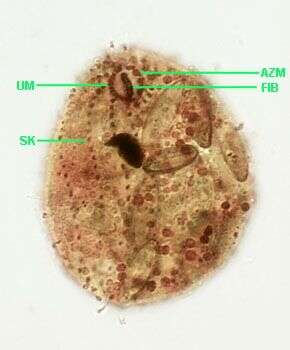
Ventral infraciliature of the colpodid ciliate, Platyophrya vorax (Kahl,1926). The flask-shaped cells are very flexible. The relatively small ovoid anterior cytostome is subapical. There is a right paraoral membrane composed of dikinetids (UM) and four rectangular left adoral membranelles (AZM). There is a postoral "pseudomembrane" consisting of closely spaced anterior dikinetids of somatic kineties (not well preserved in this specimen). The dark vertical band in the center of the cytostome probably represents densely staining pharyngeal fibers seen end-on (FIB).The right side is more densely ciliated than the left. The slightly spiralled somatic kineties (SK) lie in shallow cortical furrows. The central spherical macronucleus has a small central nucleolus and an adjacent micronucleus. The single contractile vacuole is subterminal posteriorly. Ingested diatoms are visible here.P. vorax lacks endosymbiotic algae (present in P. sphagni which also has more numerous adoral membranelles and somatic kineties).Collected from temporary puddles with heavy growth of diatoms in a meadow near Boise, Idaho. 43�41'45.09"N 116�13'55.29"W elev.3191 ft. March 2006. Stained by the silver carbonate technique (see Foissner, W. Europ. J. Protistol., 27:313-330;1991).Brightfield.
-

In vivo portrait of the colpodid ciliate, Platyophrya vorax (Kahl,1926). The flask-shaped cells are very flexible. The relatively small ovoid anterior cytostome is subapical. There is a right paraoral membrane composed of dikinetids and four rectangular left adoral membranelles. There is a postoral "pseudomembrane" consisting of closely spaced anterior dikinetids of somatic kineties. The right side is more densely ciliated than the left. The slightly spiralled somatic kineties lie in shallow cortical furrows (best seen by DIC in vivo). The central spherical macronucleus has a small central nucleolus and an adjacent micronucleus (both seen in this image). The single contractile vacuole is subterminal posteriorly. P. vorax lacks endosymbiotic algae (present in P. sphagni which also has more numerous adoral membranelles and somatic kineties).Collected from temporary puddles with heavy growth of diatoms in a meadow near Boise, Idaho. 43°41'45.09"N 116°13'55.29"W elev.3191 ft. March 2006. DIC.
-
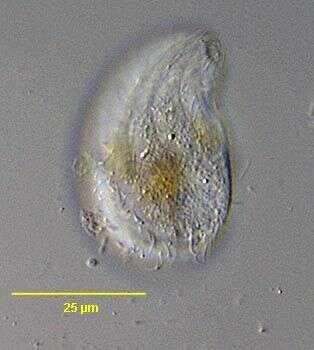
In vivo portrait of the colpodid ciliate, Platyophrya vorax (Kahl,1926). The flask-shaped cells are very flexible. This slightly distressed individual is more globular than unstressed cells.The relatively small ovoid anterior cytostome is subapical (seen here). There is a right paraoral membrane composed of dikinetids and four rectangular left adoral membranelles. There is a postoral "pseudomembrane" consisting of closely spaced anterior dikinetids of somatic kineties. The right side is more densely ciliated than the left. The slightly spiralled somatic kineties lie in shallow cortical furrows (seen here). The central spherical macronucleus has a small central nucleolus and an adjacent micronucleus. The single contractile vacuole is subterminal posteriorly. P. vorax lacks endosymbiotic algae (present in P. sphagni which also has more numerous adoral membranelles and somatic kineties).Collected from temporary puddles with heavy growth of diatoms in a meadow near Boise, Idaho. 43°41'45.09"N 116°13'55.29"W elev.3191 ft. March 2006. DIC.
-
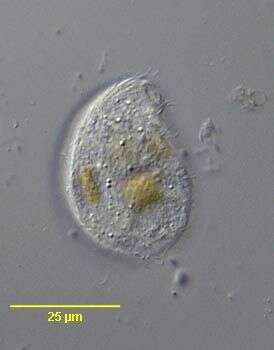
In vivo portrait of the colpodid ciliate, Platyophrya vorax (Kahl,1926). The flask-shaped cells are very flexible. This slightly distressed individual is more globular than unstressed cells.The relatively small ovoid anterior cytostome is subapical (seen here). There is a right paraoral membrane composed of dikinetids and four rectangular left adoral membranelles. There is a postoral "pseudomembrane" consisting of closely spaced anterior dikinetids of somatic kineties. The right side is more densely ciliated than the left. The slightly spiralled somatic kineties lie in shallow cortical furrows. The central spherical macronucleus has a small central nucleolus and an adjacent micronucleus. The single contractile vacuole is subterminal posteriorly. P. vorax lacks endosymbiotic algae (present in P. sphagni which also has more numerous adoral membranelles and somatic kineties).Collected from temporary puddles with heavy growth of diatoms in a meadow near Boise, Idaho. 43°41'45.09"N 116°13'55.29"W elev.3191 ft. March 2006. DIC.
-
In vivo portrait of the colpodid ciliate, Platyophrya vorax (Kahl,1926). Theflask-shaped cells are very flexible. The relatively small ovoid anterior cytostome is subapical. There is a right paraoral membrane composed of dikinetids and four rectangular left adoral membranelles. There is a postoral "pseudomembrane" consisting of closely spaced anterior dikinetids of somatic kineties. The right side is more densely ciliated than the left. The slightly spiralled somatic kineties lie in shallow cortical furrows (seen here). The central spherical macronucleus has a small central nucleolus and an adjacent micronucleus. The single contractile vacuole is subterminal posteriorly. P. vorax lacks endosymbiotic algae (present in P. sphagni which also has more numerous adoral membranelles and somatic kineties).Collected from temporary puddles with heavy growth of diatoms in a meadow near Boise, Idaho. 43°41'45.09"N 116°13'55.29"W elev.3191 ft. March 2006. DIC.

